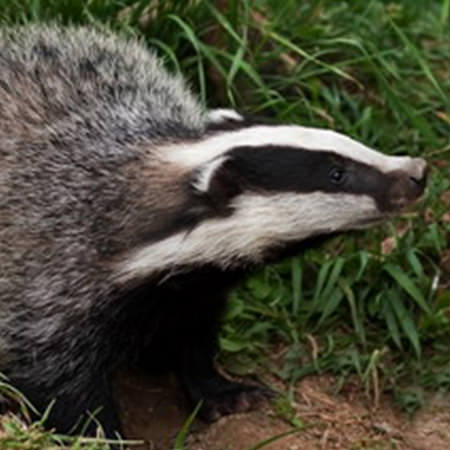Practical techniques: Badger
UK and Ireland
Badgers (Meles meles) are widespread throughout the British Isles and Ireland, although they are most common in south-west England. Badgers generally live in small groups called social groups, each group having its own territory with boundaries marked by regularly spaced latrines (small areas where badgers deposit faeces). The group also shares an underground home called a main sett, though there may also be smaller outlier setts within the territory.
Protection and its implications
Under the Protection of Badgers Act 1992, it is illegal to wilfully kill, injure or take a badger or attempt to do so, or to recklessly damage, destroy or obstruct access to any part of a badger sett. Similar protection is given by the Wildlife (Northern Ireland) Order 1985 (as amended) and the Wildlife Amendment Act 2000. The badger is a relatively common animal and the protection is there to prevent badger baiting and other blood sports involving badgers, rather than to conserve badger populations.
Nevertheless, the presence of badgers on a development site can still lead to planning permission being refused. To mitigate against this, you must clearly demonstrate that the species will be adequately protected during the development process, that disturbance is kept to a minimum, and adequate alternative habitat is provided to sustain at least the existing population.
Because they are quite common, badgers are frequently present on or near development sites. They generally build their setts on sloping ground under trees, but setts are also found in less obvious places, such as the edges of arable fields, in disused pipes and even under motorway bridges.
In England, guidance on activities considered likely to disturb badgers changed in 2009. Natural England now considers many activities around badger setts to be unlikely to disturb badgers and such activities will therefore not require a licence. Examples of such activities given by Natural England include vegetation clearance, clearing water ditches and development activities, where the sett will not be damaged and the noise and/or vibration levels will not exceed levels commonly tolerated by badgers.
Natural England also issued, in 2009, guidance on what constitutes a badger sett that is in current use by badgers. This is important because the legislation only protects badger setts that are in current use by badgers. The guidance concludes that a badger does not have to actually be in occupation of the sett for the sett to be regarded as in current use and that the sett should be considered as being in current use if badger field signs, such as footprints, badger hair, bedding, etc. are present at the sett entrance. As soon as such signs disappear, and there are no badgers occupying the sett, then it may be regarded as not in current use and is therefore not protected. Natural England states that it may take several weeks for the signs to disappear after the badger has ceased to occupy the sett.
Licences for badgers are therefore only likely to be required when:
- Works will occur at or near a badger sett showing clear signs of current use
- The sett will be damaged or destroyed
- There will be fairly extreme noise or ground disturbance in proximity to the badger sett
Additionally, where significant areas of foraging habitat are lost, it may also be necessary to create new foraging areas within the badgers’ territory in order to avoid what may be perceived as cruelty to badgers.
Mitigation techniques
Protection of individual badgers
Ideally badger setts and foraging habitat should be retained within the development site. Works close to the sett may require a licence.
If badger setts cannot be retained within the development site, then badgers may be excluded from their sett under licence to protect them from being harmed during development. This is done using a system of one-way gates and badger-proof fencing. The badgers are not captured but allowed to leave the sett via a one-way gate and then prevented from returning by the fence. The process may take up to 3 weeks to complete and, once the licence holder is confident that all the badgers have departed, the sett is carefully excavated. Translocation of badgers to a new site is usually not feasible since badgers are territorial and occur at high densities in all areas of suitable habitat.

Large numbers of badgers are killed on the roads every year and the protection of badgers is a special consideration whenever new roads are built. Badger mortality on roads can be controlled using badger-proof fencing and providing safe crossing points such as badger tunnels and ledges inside oversized culverts.
Maintaining habitats for badgers
Badger setts are typically found in woods or thick hedgerows. Their favoured foraging areas are short, improved grassland with high densities of earthworms. Maintaining these features in or around the development is therefore desirable. It is important to note that protecting the sett whilst removing large areas of badger habitat may not be acceptable.
Monitoring
Badgers can be watched at the sett without a licence, and their droppings and footprints can be easily identified. It is also relatively straightforward to determine if a sett is currently being used by badgers. However, a disused sett may become occupied again. Some small setts towards the edge of the territory may only be used sporadically. Monitoring should focus on signs and direct observations, including with the aid of camera traps, of badgers and their cubs, which first come above ground in May.
Timing of works
The period for carrying out licensed sett disturbance is normally 1st July to 30th November (thus the close season is between 1st December and 30th June).
Further reading
English Nature (2002) Badgers and Development. English Nature, Peterborough.
National Road Schemes. National Roads Authority (Date Unknown) Guidelines for the Treatment of Badgers prior to the construction of National Road Schemes. National Roads Authority, Dublin.
Natural England (2015) Badgers: surveys and mitigation for development projects. https://www.gov.uk/guidance/badgers-surveys-and-mitigation-for-development-projects